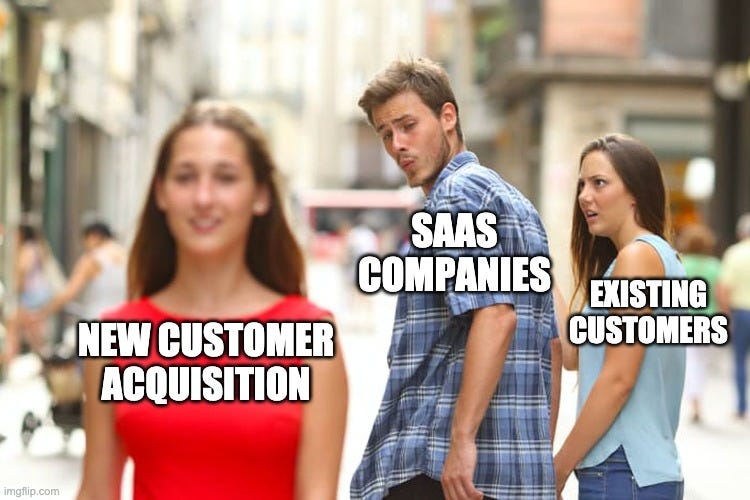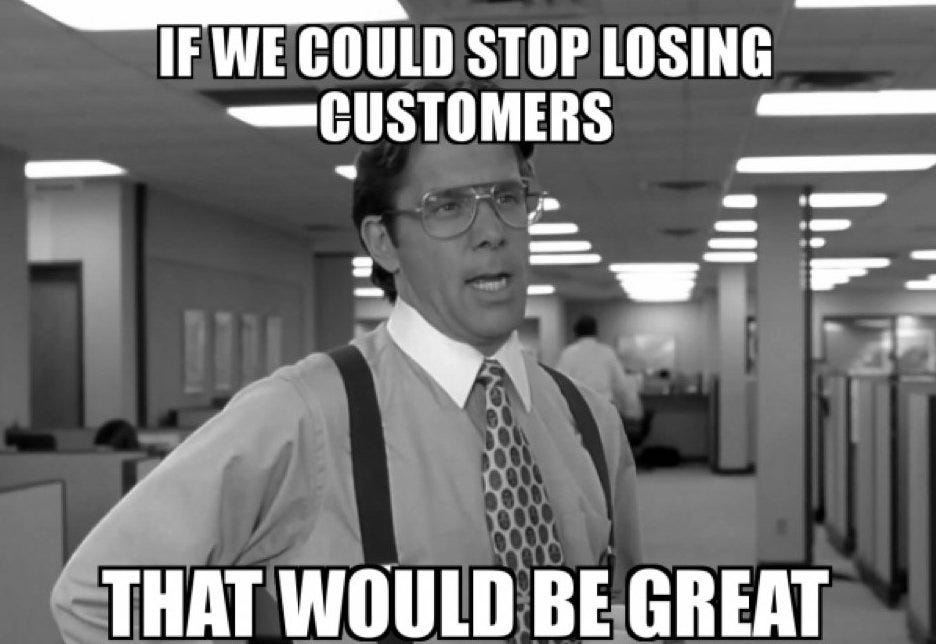How to Approach an Increasing Subscription Churn?
And where to focus your attention on.
In today's post, I will be exploring a critical issue that's been on my radar for quite some time: user churn in subscription business models. Often underestimated, churn is a pivotal challenge for businesses reliant on recurring revenue. The ability to retain customers isn't just a metric; it's a crucial determinant of a subscription business's success or failure.
I'll unravel the complexities of churn, impact on different teams within your organization, and most importantly, how to effectively address it to sustain growth and profitability.
What Exactly is Subscription Churn?
Subscription churn is the number of customers/subscribers who stop paying for a product or service within a specific period. It can also be defined as the rate at which a subscription company loses subscribers due to cancellations or expirations.
Think of it as the rate at which your subscribers are turning off the tap on their monthly or annual subscriptions. This could be due to various reasons – from dissatisfaction with the service to finding a better offer elsewhere.
There are two types of churn by definition:
Voluntary Churn: Here, the customer is leaving because they are no longer happy with the product, its features, or its pricing.
Involuntary Churn: Here, the customer can't continue using a service for reasons that are partially or entirely out of their control (e.g., payment method fails, credit card expired, forgot to renew subscription, etc.).
How Do We Usually Measure Churn?
Churn is typically measured in percentage and it's the proportion of subscribers who leave during a certain time period divided by the total number at the start of that period.
Churn Rate = (Total Lost Customers / Customers in the Period) x 100
ex.
Why Should You, as a Business Leader, Investor, or Stakeholder, Care About Churn?
Because it's not just an indicator of lost customers; it's a direct reflection of your business's health and sustainability. A high churn rate can be a warning sign of deeper issues within your offering or customer experience. Conversely, a low churn rate indicates strong customer satisfaction and loyalty – key drivers for sustainable growth and profitability.
What Are Churn Rates Across B2B and B2C SaaS Companies?
There are businesses and sectors where churn rates can be extremely high or low, which is usually not the case for most businesses.
On average, churn rates for:
B2C SaaS companies is around 7%
Reason for higher rate: The reason for this higher rate is primarily due to the higher volume of users and the nature of consumer behavior. B2C customers often make quicker decisions and can be more influenced by market trends, new competitors, or changes in personal preferences.
Additional reasoning: In the consumer market, especially for lower-priced subscription services, users may switch services based on promotions or trials from competitors. Industries like digital media or streaming services often experience seasonal fluctuations in their churn rates.
B2B SaaS companies is around 5%
Reason for lower rate: B2B relationships are typically longer-term and contract-based, offering more stability. The decision to unsubscribe from a B2B service is often more calculated, involving multiple stakeholders and a consideration of how integral the service is to business operations.
Additional reasoning: For enterprise-level SaaS products, the churn rate can be even lower, often due to the high level of integration and customization involved in these services. However, the impact of churn in B2B can be more significant due to the higher value of each customer.
What is the Impact on Having High Subscription Churn?
Having users leave your product is not the only impact it causes on your business. There are 4 major areas that I believe are the hardest hit from increasing subscription churn.
Impact on Revenue
Let's break down the impact on Revenue into smaller pieces, which allows better communication.
Direct Revenue Loss:
Every churned subscriber is essentially a closed revenue stream. Expand your thinking to be not only at the present moment of cancellation, but also the compounding effect of missing out on future recurring payments.
Imagine a churn rate of 7% for a $20 monthly subscription. That translates to a staggering $1,680 lost revenue per year for 100 subscribers. How about 1,000 subscribers ($16,800 lost)? How about 5,000 subscribers ($84,000 lost)?
Increase in Customer Acquisition Cost ( CAC ):
This is where it gets interesting, because every lost subscriber not only decreases your current and future revenue streams but also requires you to spend more at the top of the funnel to acquire new customers. Replacing lost customers requires constant acquisition efforts, and CAC can be significantly higher than retention costs. For SaaS businesses, the difference can be around 5x to 10x, meaning that you could spend $50 to acquire a new customer, who would pay you $10 a month.
Reduced Predictability
High churn introduces volatility into revenue projections. It becomes difficult to forecast future income accurately, hindering strategic planning and investment decisions.
Impact on Retention
Reduced Upsell and Cross-sell Opportunities
The easiest wins here are with customers who are retained and loyal. The more users churn, the fewer opportunities there are to upsell or cross-sell your product/service.
Decreased Customer Lifetime Value ( or CLTV )
Firstly, as a definition, CLTV represents the total revenue a customer generates over their engagement with your business. Again, this impacts your overall profitability and growth potential, as churning users usually have lower CLTV.
Negative Customer Satisfaction
Let's not overlook the negative impact, not only on revenue but also on your brand. Churn, often stemming from bad product experience, may lead to a negative ripple effect throughout your customer base, fostering a poor perception that can influence potential subscribers.
Impact on PLG ( or Product-Led Growth motions )
Product-Market Fit
If you experience high churn, this might indicate a negative product-channel fit experience. It’s usually a red flag prompting deeper analysis of user behavior and “potential” feature gaps.
Onboarding
Your first touchpoint with new customers is crucial. That's why if you have poor user onboarding, this can easily lead to churn before the user even fully grasps the product value.
Engagement & User Activities
In SaaS models, user activity and engagement are key factors that signal how well your product is solving their problem. PLG models rely on active user involvement to unlock value, so optimizing product features and in-app guidance becomes vital.
Feedback Loops & Iteration
You should get the best from users, especially the churning ones. Analyzing their reasons for leaving can inform product improvements and feature iterations, ultimately strengthening the product-market fit and reducing future churn.
Impact on Internal Teams
Marketing & Sales
High subscription churn rates immediately put pressure on these teams, as they need to constantly acquire new customers while trying to keep costs and margins lower, which is challenging.
Product
Churn can indicate a misfit between the product and the market or reveal missing features. The responsibility of scrutinizing churn data and making product enhancements often falls on development teams, which can result in a heavier workload and heightened pressure for swift delivery.
Finance & Operations
Churn has a direct effect on revenue and profit margins, leading to increased pressure on teams to efficiently handle budgets and resources. Moreover, elevated churn rates may require implementing cost-reduction strategies, which can further affect team morale and operational efficiency.
Customer Success
Churning customers are a clear indicator of shortcomings in providing value and satisfaction, posing a significant challenge for customer success teams. These teams, dedicated to cultivating positive relationships and nurturing loyalty, may find such churn rates disheartening, as it reflects directly on their efforts to engage and retain customers effectively.
What To Do When Our Churn Start Increasing?
Every SaaS business has its unique issues and business nature. Depending on your industry and ICP (Ideal Customer Profile), this can make things even more complex. But, on a high level, there are common strategies you can start working on to increase your revenue subscription growth and decrease user churn.
Start with understanding the “WHY”
It might sound trivial to some, but understanding such an important issue usually starts with asking the right questions and deep diving into your own data. From there, you tend to create hypotheses and focus on specific areas, rather than drifting around and wasting resources/time.
Zoom, for example, analyzed their churn data and discovered that at a certain point, their users were overwhelmed by features. How did they solve it? By simplifying the interface and offering guided tutorials, which decreased churn by 15%.
Onboard like a champion
User onboarding is the only place where you touch 100% of newly acquired users and it's the perfect place to show value early. Make the initial experience smooth and delightful. A few ideas to start with: Offer intuitive tutorials, personalized recommendations, and proactive support to guide users towards value.
Dropbox, known for experimenting and getting the onboarding experience right, managed to increase retention by up to 23% within the first 30 days by gamifying it with progress bars and badges.
Work hardly on your activation and engagement metrics.
Defining your activation flow (setup > aha > habit moments) is probably the most interesting & consuming area to spend time in order to build the right metrics, frequency of engagement, and different states. This is directly correlated with your subscription churn. Highlight core functionalities and encourage user exploration through targeted campaigns and in-app guidance. Show them the "aha!" moments your product offers!
Slack, one of the PLG business models out there, introduced “Channels for Everyone” campaigns, showcasing the platform's versatility and boosting user engagement, contributing to a 5% churn reduction.
Test & optimize pricing
Experimenting with pricing is a pivotal step in every SaaS business. Start by understanding your core users and offer different subscription plans catering to diverse needs and budgets.
Canva introduced a free tier plan with limited features alongside paid plans, attracting new users and eventually converting them to paid ones by showing them a glimpse of what's possible. Doing this helped the company reduce churn by approximately 10%.
Personalization is key
By understanding & reducing subscription churn, you need to first know in detail the different cohorts of users you have. That’s why personalization is a key element here. Segmenting users based on behavior and preferences allows you to experiment & set better personalized emails, push notifications, or in-app messages with on-point content, relevance, and timing.
Netflix recommends content based on individual viewing habits, fostering a sense of personal connection and driving engagement, with a churn rate of just 2.3%.
Get deeper into “inactive” customers
Don’t write off inactive users. Instead, learn from them and understand what was driving them before, but not anymore. Create targeted re-engagement campaigns to give them a second chance to re-explore your product/service. I’ve personally learned tons of valuable insights by deep diving into inactive users. In the subscription business model, they are usually plentiful.
Spotify analyzed user data and found many "long-term inactive" users had outdated music preferences. They implemented personalized email campaigns suggesting new music based on their past listening habits, leading to a 12% reactivation rate among this segment.
As a final note, I would say working in SaaS and especially looking to increase your retention and reduce subscription churn is always a challenge I’m up for.
Don’t ignore this aspect of your business and put in the work today, in order to see compounding benefits in the future. The same goes if you decide to ignore it for too long, as it might become irreversible.




